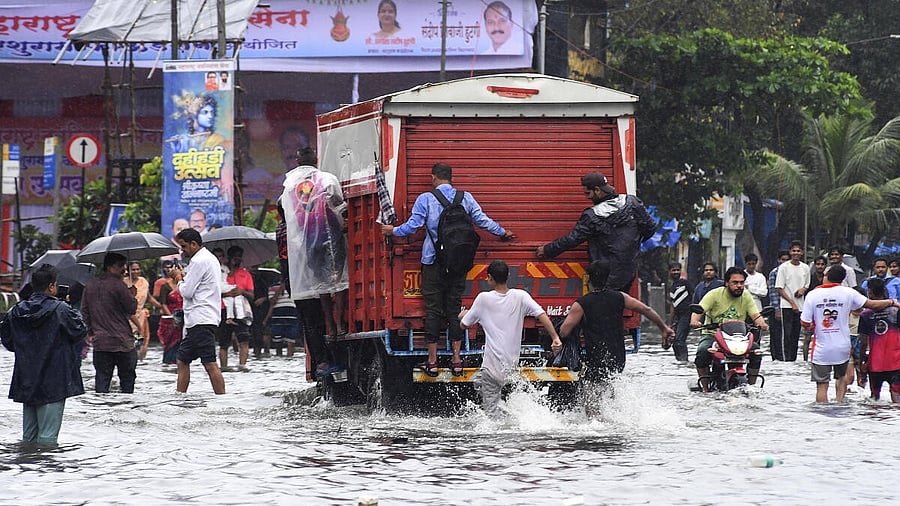
Rains in Mumbai
Credit: PTI photo
Mumbai: After remaining rain deficit for July, spells of extremely heavy rains returned to the city around mid-August creating havoc.
While three-digit rainfall is not new to the city, climate change certainly has a role to play.
A new Climate Trends briefing — “Mumbai Rains: Early warning systems and adaptation plans are the only way out” — brings together leading voices on the issue, who agree that advance warnings, better planning, and adaptation are Mumbai’s only way forward to protect lives, livelihoods, and critical infrastructure.
From 15-16 August, parts of Mumbai and the larger Mumbai metropolitan region (MMR) has received over 800 mm rainfall.
“While there is a natural variability of monsoon weather systems, climate change acts like a steroid. The northward swing of the southwesterly monsoon winds are pumping massive amounts of moisture from the warm Arabian Sea into northern Western Ghats.
"This northward swing is a combination of global warming, especially the warming over the Middle East, and the natural variability of the monsoon winds,” said climate scientist Dr Raghu Murtugudde, Emeritus Professor, University of Maryland and Retired Professor, IIT-Mumbai.
“Mumbai’s torrential downpour is the result of strong monsoon winds lashing the city, intensified by the combined pull of a low-pressure system over east India and another over the Gulf of Khambhat. This sudden burst of rain follows the city’s driest July since 2015, which failed to meet its monthly average rainfall.
"Whilst the exact role of climate change in this particular event will need to be assessed through scientific studies, the overall trend is evident: more intense rainfall occurring over shorter durations is consistent with what we expect in a warming world. Extreme weather events like this are becoming increasingly common, and Mumbai needs to find a way forward to adapt and build resilience against such extreme events,” said Dr Akshay Deoras, Research Scientist, National Centre for Atmospheric Science, University of Reading, UK.
“We all know that there has been a rise in temperature due to global warming. Secondly, the exponential warming of the Arabian Sea has increased the moisture influx along the West Coast, contributing to heavy precipitation. In this scenario, the only way out is to have a very good network of early warning systems, nowcast systems for urban flooding. More importantly, these advance warning systems should be citizen-centric, which means the information should reach out to people so informed decisions can be taken,” said Dr Subimal Ghosh, Institute Chair Professor, Department of Civil Engineering & Convener, Interdisciplinary Program in Climate Studies-IIT Mumbai.
“While forecasting has been improving, coordination between the multiple working agencies is still a challenge. If the information is not disseminated at the right hour, then we will also fail the purpose of timely forecasting. With extreme weather events now being regular visitors, we need to identify high-risk zones or flood-prone areas in the city.
"There should be an evacuation process as well as a well-defined escape route. This cannot be done overnight,” said K G Ramesh, former Director General, India Meteorology Department.
“Apart from early warning systems, we also need to strategize various other ways to deal with urban flooding. To begin with, there should be a mapping of urban flooding that includes identifying flood-prone areas in the given city and conducting exercises to ascertain the flood levels. Thereafter, the focus should be on actions required that might include the upgradation of the drainage system or increasing green cover that might help to improve the absorption mechanism of the excess water.
" We need to come out with some practical solutions on the ground to be able to manage urban flooding better.
"This can also include creating an IDF (Intensity-Duration-Frequency) mechanism, which can give us an idea of which part of the city would receive how much rainfall in the future and what would be the water discharge. This would help the authorities,” said Dr Vishwas Chitale, Fellow, Council on Energy, Environment and Water (CEEW).